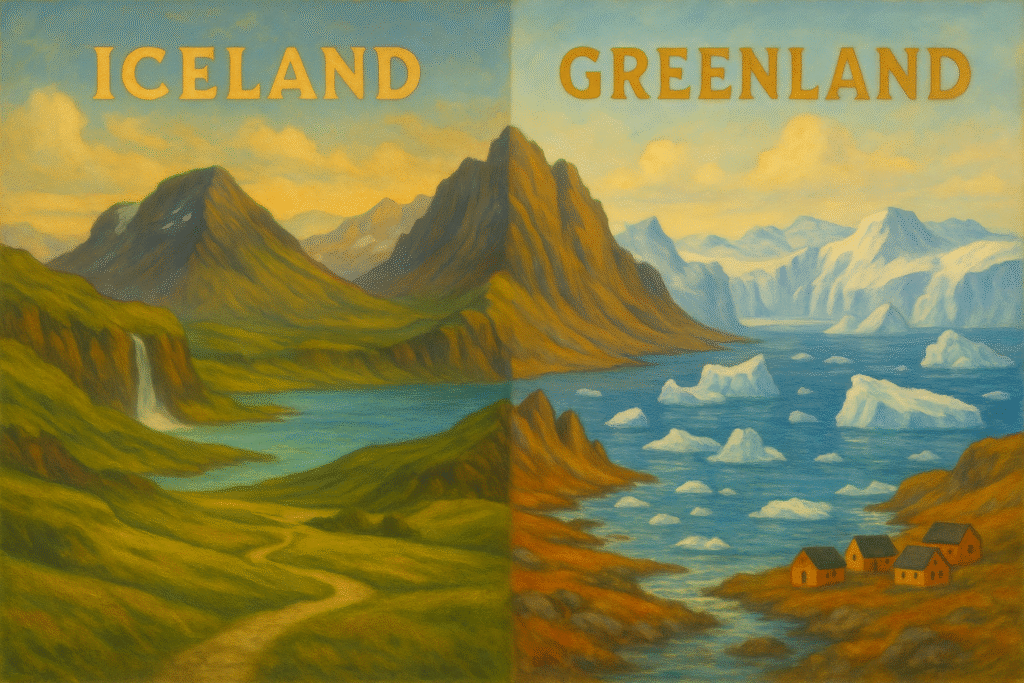When exploring Iceland and Greenland, many travelers wonder if Iceland is truly green and Greenland icy. These enigmatic names tell only part of the story. Both destinations offer diverse natural wonders and rich cultural experiences. Dive into our ultimate guide to uncover the truth and plan your next eco-conscious adventure.
1. Iceland: The Verdant Wonderland
1.1 Why is Iceland Known for Its Greenery?
Iceland, often called “The Land of Fire and Ice,” is renowned for its lush landscapes, which defy its icy name. Geothermal energy sustains vibrant green valleys and diverse flora. According to the Icelandic Tourist Board, over 80% of Iceland’s energy comes from renewable sources, underscoring its eco-friendly reputation.
1.2 Exploring Iceland’s Sustainable Tourism
Iceland leads in sustainable tourism, offering renewable energy-powered accommodations and eco-centric activities. Visitors can:
1. Hike the Sólheimajökull Glacier
2. Relax in the geothermal Blue Lagoon
3. Explore Iceland’s 179 nature reserves
Icelandic sustainability practices focus on minimal environmental impact, promoting harmony between tourism and nature.
2. Greenland: Beyond Its Icy Name
2.1 Is Greenland Just Ice?
Despite its icy reputation, Greenland showcases diverse landscapes. Known for dramatic fjords and vibrant tundra, summertime reveals unexpected greenery amidst glaciers. Visit Greenland highlights the country’s unique wildlife, including polar bears and Arctic foxes, offering an enriching experience year-round.
2.2 Discover Greenland’s Uncharted Territories
Greenland tempts adventurers with its untouched beauty:
1. Explore Inuit culture in remote settlements
2. Sail through iceberg-laden waters
3. Experience the Northern Lights from secluded vantage points
Engaging local guides ensures you experience Greenland’s authentic culture while respecting its fragile environment.
3. Iceland vs. Greenland: A Travel Comparison
3.1 Geographical and Cultural Contrasts
| Feature | Iceland | Greenland |
|---|---|---|
| Geographical Highlights | Volcanoes, geysers, green valleys | Icebergs, fjords, tundra |
| Cultural Experiences | Viking history, modern arts | Inuit heritage, traditional storytelling |
| Best for Adventure | Geothermal hiking, active volcano tours | Ice fjord cruising, wildlife spotting |
3.2 Practical Travel Considerations
For travelers evaluating costs or accessibility:
* Iceland offers year-round flights and lower travel costs.
* Greenland, while pricier, delivers exclusivity and fewer tourists.
* Both destinations boast opportunities for witnessing the Northern Lights, with peak viewing from September to April.
4. Best Travel Times for Iceland and Greenland
4.1 Which Season Offers the Most?
* Iceland: Summer (June – August) offers extensive daylight, perfect for hiking and exploring natural hot springs.
* Greenland: Summer showcases rare blooms and wildlife, ideal for outdoor adventures and cultural immersion in Inuit settlements.
For a winter wonderland experience, both destinations offer unique attractions like ice cave tours and dog sledding.
Conclusion: Embark on a Journey Beyond Names
Iceland and Greenland offer more than their names suggest, each beckoning travelers with unique landscapes and rich cultures. Prioritize eco-conscious travel and gain profound insights into these remarkable lands. Embark on your adventure today by exploring sustainable travel options, understanding local cultures, and immersing yourself in nature’s breathtaking beauty.



Pingback: Iceland vs Greenland Travel: Unveiling the Distinct Characteristics - thenoetik.com